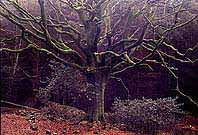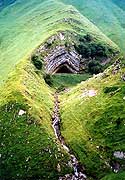 |
|||||||||||||
|
Welcome
to the Pavilion of the Formori Community For us, being a Formori is like choosing a different path to look at the world from a unusual perspective, to redefine our priorities in our lives and focus on what we think is really important: a meaningful life, good and loyal friends and the preservation of harmony. To
achieve this, we have set ourselves the goal of re-creating a whole
culture dedicated to the ancient Formoris, a people of the Bronze Age
in Western Europe which was wipped out by the first Indo-Europeans.
Through them, we wish to honor all the peoples who have been removed
from the surface of our planet with their cultures, their beliefs and
their wisdoms definitely lost. |
|
A
living pavilion |
To get more
information, you can also visit our website in English
or in French
or contact us directly.
|
According to Irish myths, the Formoris were a people from the sea who opposed the invasion of Ireland by the Tuatha Dé Danann and were eventually defeated by them and repelled from this world. They were later turned into cyclops and one-legged monsters to play the traditional villains in folk tales. We, of course, have developed our own version of this myth, based on ancient Irish tales and other legends which we thought might refer to the ancient Formoris. Our myth begins with the migration of an unnamed people from the valleys of Caucasus to the shores of the Gulf of Gascony.
After a series of invasions by the sea, they discovered war and their two major colonies, Bara and Yloxa, almost started one. The conflict was stopped by Môri, the Lady from the Cave, who gave them Orna, the Sword of Unity and symbol of the friendship between tribes. That's why they became "Zormoryeny" which means "those who have a debt to Môri." For centuries they lived in peace, dealing with Tartessians coming from Southern Spain and Keftyos from Crete. Many young Formoris left their country to serve as mercenaries for the Keftyos and some of them fought in Egypt and in the Middle East. Others sailed to distant islands and found new fishing places near Newfoundland. |
But one day, a violent people arrived from the East and claimed new lands to settle. They called themselves the People of Dana and fought several peaceful tribes who asked the Formoris for protection. The Formoris defeated the Daneans and forced them into peace. A renegade Tartessian prince, Leukos, took the leadership of a Danean rebellion and defeated the Formoris. He later walked on Bara with his troops and besieged an army of women. He died when the city eventually sunk into the sea during the last battle.
When building up this myth, we were amazed to discover numerous possible connections with other stories from Nordic, Greek and Basque mythologies, from old pagan and christian folklore from Northern Spain, and even from a few Amerindian legends. |
The
Formori myth is still in its building phase and is regularly enriched by new
elements,
some of them will be presented here during the exposition.
To read the tales, click below:
The
Tale of the Redhead Warriors
The Tale of the Feast of Heroes
The Tale of the Birth of the Twins
The Tale of the Death of Cwanos
|
The Formori myth, with its dramatic and tragical end, is a powerful source of inspiration for epic poetry. |
Below is the English transcript of Sennaun e'aroyn xaoneat, one of our most famous traditional laments. |
Song of the long-forgotten smith
(Apocryphal lament)
Sparkle, sparkle!
My hammer on the blade
I don't fear the heat
I don't fear the blaze
I don't mind the bite of the flame
On my hand
I am son of the heavenly bull
I know the secret of the lightning
And how to turn rocks into spades
Sparkle, sparkle!
My hammer on the blade
I don't feel no harm
I don't feel no pain
The burning iron carved my name
In the sand
Sparkle, sparkle!
My hammer on the blade
Makes you fly high
And shine in the skies
I forgot that your deadly kiss
Could light the wildest fires
Sparkle, sparkle!
My hammer on the blade
All my children are gone
Meat to the ravens
Their blood flowed in the plain
Their souls lie in the cave
I was son of the sacred tree
I knew the secret of the lady
And many songs for her I could play
Sparkle, sparkle!
Shimmering on the shade
All my friends are gone
Nothing is left but pain
The city burnt down in flame
And no one to remember its name
|
One of the most important element of a culture is its traditional clothing. Formoris do not wear ties, and modern Formoris do not dress like a Bronze Age people either. |
Numerous studies have been conducted on basic, traditional and modern customs. Some drawings and pictures will be presented here all along the exposition. |
|
On August 4, the Formoris will celebrate Ornasayn, the day of abondance. |
Watch out for recipes of a traditional, and very tasty, Formori banquet! |
|
Formori music covers various modes, from lament to festive songs, and styles including polyphonies by a capella singers and the typical "single-handed music." |
We plan to provide you several music files to download and play while browsing through this pavilion. |
This section had to be cancelled for technical reasons.
|
The Formoris are real people, with real lives, passions and achievements. Over nearly 10 years, some 85 people became Formoris. |
To know better some of our most famous nationals, click on the names below to enter the gallery of portraits. |
|
|
Marsor Goromer yg Ornemalyn |
Corcyn Sarmetenyr yg Orynz Corcyn Gaezwr yg Symar |
Thank you
for your visit and please come back often
as the content of this pavilion will expand
This
way back to the Micronational Exposition
© Formori Institute 2001 (3508)
 They
settled in what is now southwestern France and the Basque country where
they met several other indigneous people, and lived with them in harmony,
worshiping their sacred tree.
They
settled in what is now southwestern France and the Basque country where
they met several other indigneous people, and lived with them in harmony,
worshiping their sacred tree.
 Then
Môri came with all the surviving women to collect the bodies of
the Formoris killed during the fight and bring them into her cave where
they will sleep forever.
Then
Môri came with all the surviving women to collect the bodies of
the Formoris killed during the fight and bring them into her cave where
they will sleep forever.